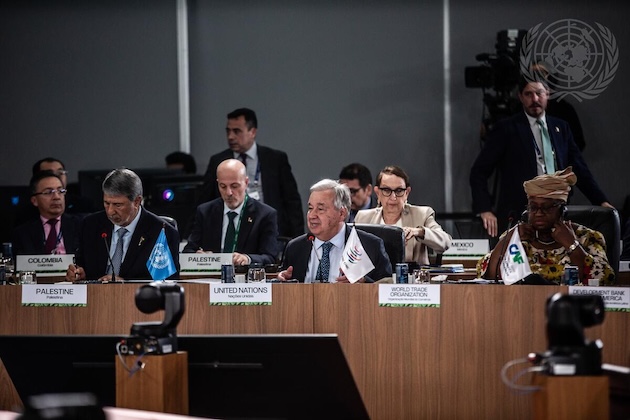
Active Citizens, Africa, Civil Society, Development & Aid, Editors’ Choice, Featured, Headlines, Health, Human Rights, Humanitarian Emergencies, Sustainable Development Goals, TerraViva United Nations, Youth

Rallying call to end TB by 2030. Credit: Busani Bafana/IPS
– Every day, Yondela Kolweni has to hold down her son, who screams and fights when it is time for his daily life-saving TB tablets—a painful reminder of her battle with the world’s top infectious killer disease.
“It is a fight I win feeling awful about what I have to do,” says Kolweni (30), a Cape Town resident and a TB survivor. “The tablets are bitter, and he spits them out most of the time, and that reminds me of the time I had to take the same pills.”
Kolweni’s five-year-old son is battling Multidrug Resistant TB (MDR TB), a vicious form of TB that is rising among children globally.
The global burden of MDR-TB among children and adolescents has increased from 1990 to 2019, particularly in regions with lower social and economic development levels, according to a recent study. In addition, the top three highest incidence rates of MDR TB in 2019 were recorded in Southern sub-Saharan Africa, Eastern Europe, and South Asia, while the top three highest rates of deaths in the same period were recorded in Southern, Central, and Eastern sub-Saharan Africa.
South Africa is one of 30 countries that account for 80 percent of all TB cases in the world and has the most cases of drug-resistant TB.
A Bitter Pill to Swallow
Kolweni’s son was diagnosed with MDR-TB five years ago, having tested positive for TB which has affected his grandmother and his mother. He was immediately on treatment, a drug cocktail that included moxifloxacin—a pill not for the yellow-livered.
“There were two medications he had to take, and there was one specifically, the yellow one, that he did not like, and with the color he knew what it was,” Kolweni told IPS in an interview, explaining a daily battle to get her son to take his meds.
It was down to a fight. She crushed the tablets, mixed them with a bit of water, and fed them through a syringe.
“We would sometimes hold him or wrap a towel around him so that we could feed him the medication, but he would still spit it out, which meant he was not taking the dosage he was meant to take,” said Kolweni. “We then came up with the idea to put his tablets in his yogurt, but that technique did not work because, being a smart kid, he took the bait but would soon spit out the medication.”
Moxifloxacin, an exceptionally bitter medicine, is one of the key drugs in the new all-oral treatment for multidrug-resistant tuberculosis (MDR TB). The treatment is a combination of the drugs Bedaquiline, Pretomanid, Linezolid and Moxifloxacin, known as BPaLM. The BPaLM regimen is specially formulated for children but is a bitter pill to swallow.
Sweet Medicine
But there is sweet hope. A new study, by Stellenbosch University and the TB Alliance, found that sweet, bitter-masked versions of Moxifloxacin significantly improve kids’ willingness to take the drug—easing the burden on parents and boosting treatment adherence.
Two formulations of moxifloxacin have been identified by children as tasting better than new generic versions of products currently on the market.
The results from the ChilPref ML study—a Unitaid-funded effort sponsored and led by Stellenbosch University in collaboration with TB Alliance—will help improve MDR TB treatment and adherence in children.
Dr. Graeme Hoddinott, of Stellenbosch University and the principal investigator of the study, notes that children cannot be treated in a humane manner for drug-resistant TB if the medicines taste so terrible that children refuse them or must be forced to take them.
Children diagnosed with drug-sensitive TB have good outcomes even within the four months because there is usually one tablet given, and there is a child-friendly formulation that dissolves easily to be given on a spoon or in a syringe, Hoddinott said. However, for drug-resistant TB, the situation is complicated. Most drugs for MDR TB are no longer used because of their toxicity and have been replaced by new drugs.
MDR-TB drugs are not child-friendly, Hoddinott admits. The active ingredient that kills TB in Moxifloxacin makes the pills incredibly bad tasting for children who have to take the medication daily for between six and nine months in cases of MDR TB.
“These drugs are incredibly bad tasting; they are genuinely awful to a point where adults who have been on extended TB treatment have been unable to administer the same drugs to their children because the smell evokes the time when they were sick,” Hoddinott told IPS. “It is a trauma to administer such bad-tasting drugs to a child, both for the parent and the child, particularly for the young children.”
The ChilPref study recruited just under 100 healthy children, ages 5–17, from two diverse settings in South Africa. The children evaluated flavor blends using a ‘swish and spit’ taste panel—tasting the medicine, which was dissolved in water, and then spitting it out without ingesting any of it.
Each child participant ranked the flavor blends among the three from each manufacturer and also rated the taste, smell and other characteristics of each. For moxifloxacin, there was a clear, strong preference for the new flavor blends (“bitter masker” and orange for Macleods, and strawberry and raspberry and tutti frutti for Micro Labs) over the existing commercially available flavors for both manufacturers. For Linezolid, there was no preference between the flavor blends.
“Ensuring children have access to effective and palatable TB treatments is a crucial step in improving adherence and treatment outcomes,” said Koteswara Rao Inabathina, one of the study’s authors and CMC Project Manager at TB Alliance.
“Through close collaboration with manufacturers, we have addressed critical unmet needs by developing practical solutions that make available and effective drug-resistant TB treatments not only accessible but also palatable and acceptable for children.”
The results of the ChilPref study showed that children preferred two new flavor blends of moxifloxacin, produced by Macleods Pharmaceuticals, India, and Micro Labs Pharmaceuticals, India. The results were communicated to the manufacturers, who are already updating their products.
“We are not surprised that a lot of kids did not like any of the tastings because we knew that they were horrible taste-wise, but we got a very clear signal for both manufacturers that the flavor blends we recommended were more preferred,” Hoddinott said. “We changed which flavor was going to market with relatively simple research.”
Dr. Cherise Scott, Senior Technical Manager at Unitaid, said the easier it was for children to take their medicines regularly, the more likely they were to complete their treatment successfully.
“We will not allow children to be neglected in global health responses simply because their needs are more complex.”
A Promising Treatment for MDR TB
As multi-drug-resistant TB transmission increases among children and adolescents, the development of new treatments is imperative, Hoddinott explained.
Moxifloxacin may also be increasingly used in the future for the treatment of drug-susceptible TB, which affects an estimated 1.2 million children globally each year.
Drug-resistant TB, has previously been one of the most difficult diseases to manage because of limited child-friendly treatment options, but scientists have made strides in developing new treatments for children, explains Dr. Anthony Garcia-Prats, one of the study authors and an associate professor at the University of Wisconsin-Madison.
“Now we are making sure that these medicines are appropriate for children, starting with an aspect that children and parents say is critical: taste,” Garcia-Prats said in a statement.
The new treatment is given when TB is either resistant to rifampicin, a critical first-line drug, or rifampicin and isoniazid, another first-line drug combination. These resistant strains are collectively referred to as RR/MDR-TB.
Annually there are an estimated 32,000 new cases of RR/MDR-TB among children 14 years and under—a population that is extremely sensitive to the taste of medicine, according to researchers.
This discovery could help improve adherence to TB medication and move a step closer towards the United Nations Sustainable Development Goal 3 to end TB by 2030.
“It is not a silver bullet,” Hoddinott cautions. “It does not solve everything, as people affected by TB still face many other challenges, and even the preferred flavor blends still do not taste nice. But, as part of the overall fight against TB in children, it’s an important step.”
Kolweni welcomes the development of masked TB medication.
“My experience with TB medication was not nice, and for children it is worse, and I think flavored tablets would make it easy for children to take, like Gummies,” she said. “Every child loves flavors; even a suspension would be nice. My son would love it, and I will have no trouble getting him to take his medicine.”
Note: This article is brought to you by IPS Noram, in collaboration with INPS Japan and Soka Gakkai International, in consultative status with the UN’s Economic and Social Council (ECOSOC).
IPS UN Bureau Report













